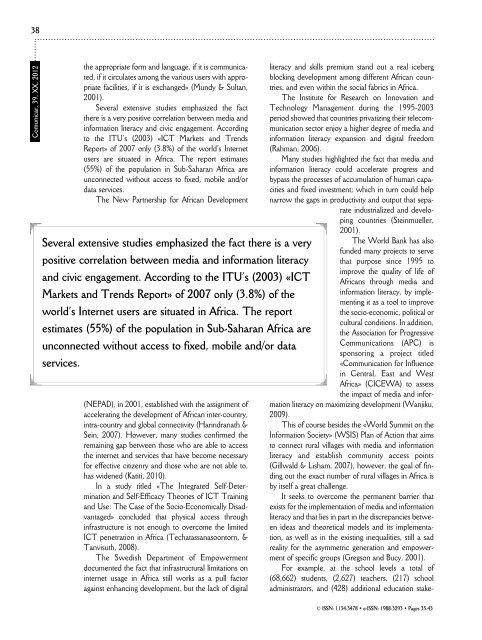Comunicar 39-ingles - Revista Comunicar
Comunicar 39-ingles - Revista Comunicar
Comunicar 39-ingles - Revista Comunicar
Create successful ePaper yourself
Turn your PDF publications into a flip-book with our unique Google optimized e-Paper software.
38<strong>Comunicar</strong>, <strong>39</strong>, XX, 2012the appropriate form and language, if it is communicated,if it circulates among the various users with appropriatefacilities, if it is exchanged» (Mundy & Sultan,2001).Several extensive studies emphasized the factthere is a very positive correlation between media andinformation literacy and civic engagement. Accordingto the ITU’s (2003) «ICT Markets and TrendsReport» of 2007 only (3.8%) of the world’s Internetusers are situated in Africa. The report estimates(55%) of the population in Sub-Saharan Africa areunconnected without access to fixed, mobile and/ordata services.The New Partnership for African DevelopmentSeveral extensive studies emphasized the fact there is a verypositive correlation between media and information literacyand civic engagement. According to the ITU’s (2003) «ICTMarkets and Trends Report» of 2007 only (3.8%) of theworld’s Internet users are situated in Africa. The reportestimates (55%) of the population in Sub-Saharan Africa areunconnected without access to fixed, mobile and/or dataservices.(NEPAD), in 2001, established with the assignment ofaccelerating the development of African inter-country,intra-country and global connectivity (Harindranath &Sein, 2007). However, many studies confirmed theremaining gap between those who are able to accessthe internet and services that have become necessaryfor effective citizenry and those who are not able to,has widened (Katiti, 2010).In a study titled «The Integrated Self-Deter -mination and Self-Efficacy Theories of ICT Trainingand Use: The Case of the Socio-Economically Disad -vantaged» concluded that physical access throughinfrastructure is not enough to overcome the limitedICT penetration in Africa (Techatassanasoontorn, &Tanvisuth, 2008).The Swedish Department of Empowermentdocumented the fact that infrastructural limitations oninternet usage in Africa still works as a pull factoragainst enhancing development, but the lack of digitalliteracy and skills premium stand out a real icebergblocking development among different African countries,and even within the social fabrics in Africa.The Institute for Research on Innovation andTech nology Management during the 1995-2003period showed that countries privatizing their telecommunicationsector enjoy a higher degree of media andinformation literacy expansion and digital freedom(Rahman, 2006).Many studies highlighted the fact that media andinformation literacy could accelerate progress andbypass the processes of accumulation of human capacitiesand fixed investment; which in turn could helpnarrow the gaps in productivity and output that separateindustrialized and developingcountries (Stein mueller,2001).The World Bank has alsofunded many projects to servethat purpose since 1995 toimprove the quality of life ofAfricans through media andinformation literacy, by implementingit as a tool to improvethe socio-economic, political orcultural conditions. In addition,the Association for ProgressiveCommunications (APC) issponsoring a project titled«Communication for Influencein Central, East and WestAfrica» (CICEWA) to assessthe impact of media and informationliteracy on maximizing development (Wanjiku,2009).This of course besides the «World Summit on theInformation Society» (WSIS) Plan of Action that aimsto connect rural villages with media and informationliteracy and establish community access points(Gillwald & Lisham, 2007), however, the goal of findingout the exact number of rural villages in Africa isby itself a great challenge.It seeks to overcome the permanent barrier thatexists for the implementation of media and informationliteracy and that lies in part in the discrepancies betweenideas and theoretical models and its implementation,as well as in the existing inequalities, still a sadreality for the asymmetric generation and empowermentof specific groups (Gregson and Bucy, 2001).For example, at the school levels a total of(68,662) students, (2,627) teachers, (217) schooladministrators, and (428) additional education stake-© ISSN: 1134-3478 • e-ISSN: 1988-3293 • Pages 35-43
















